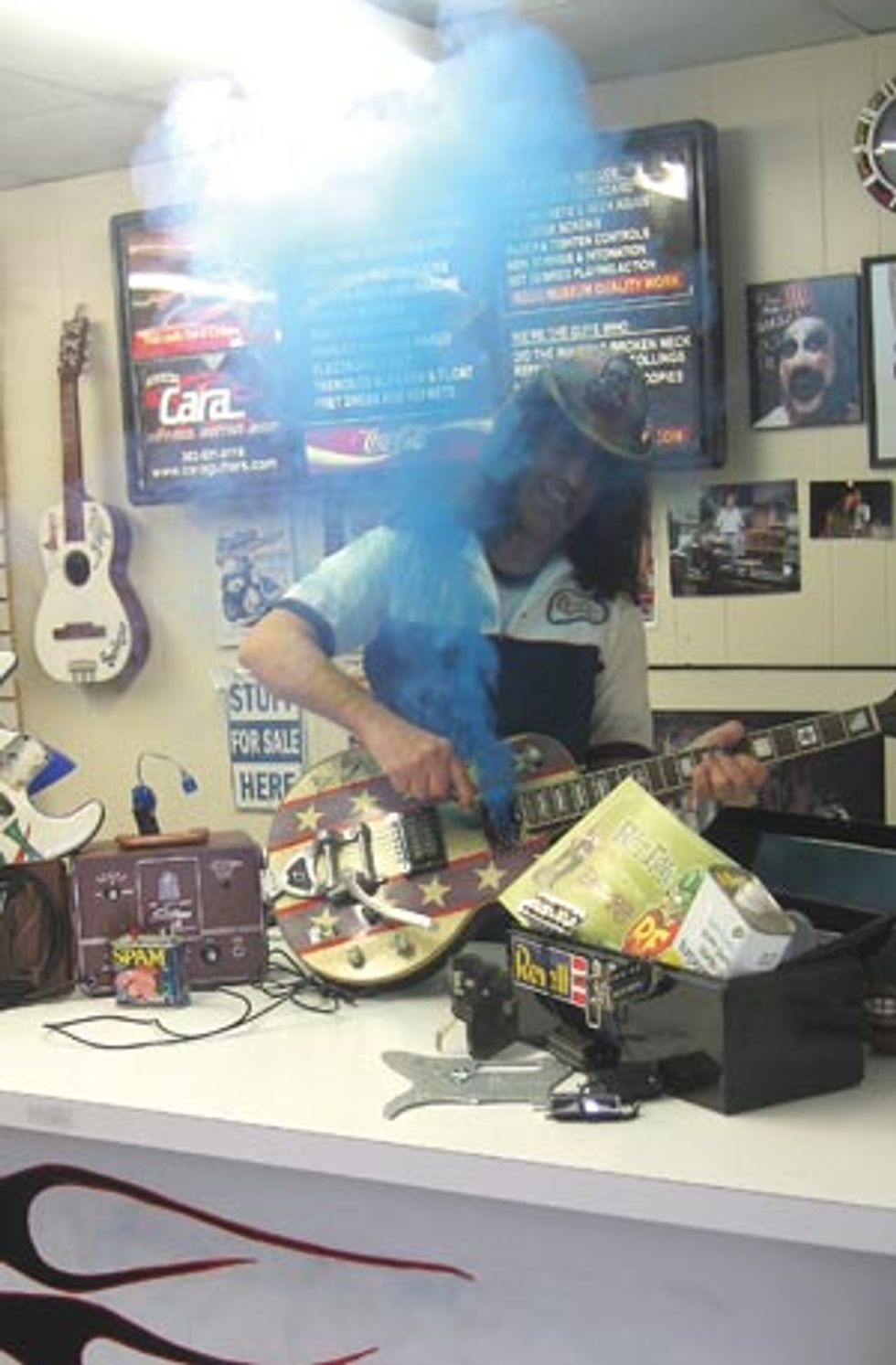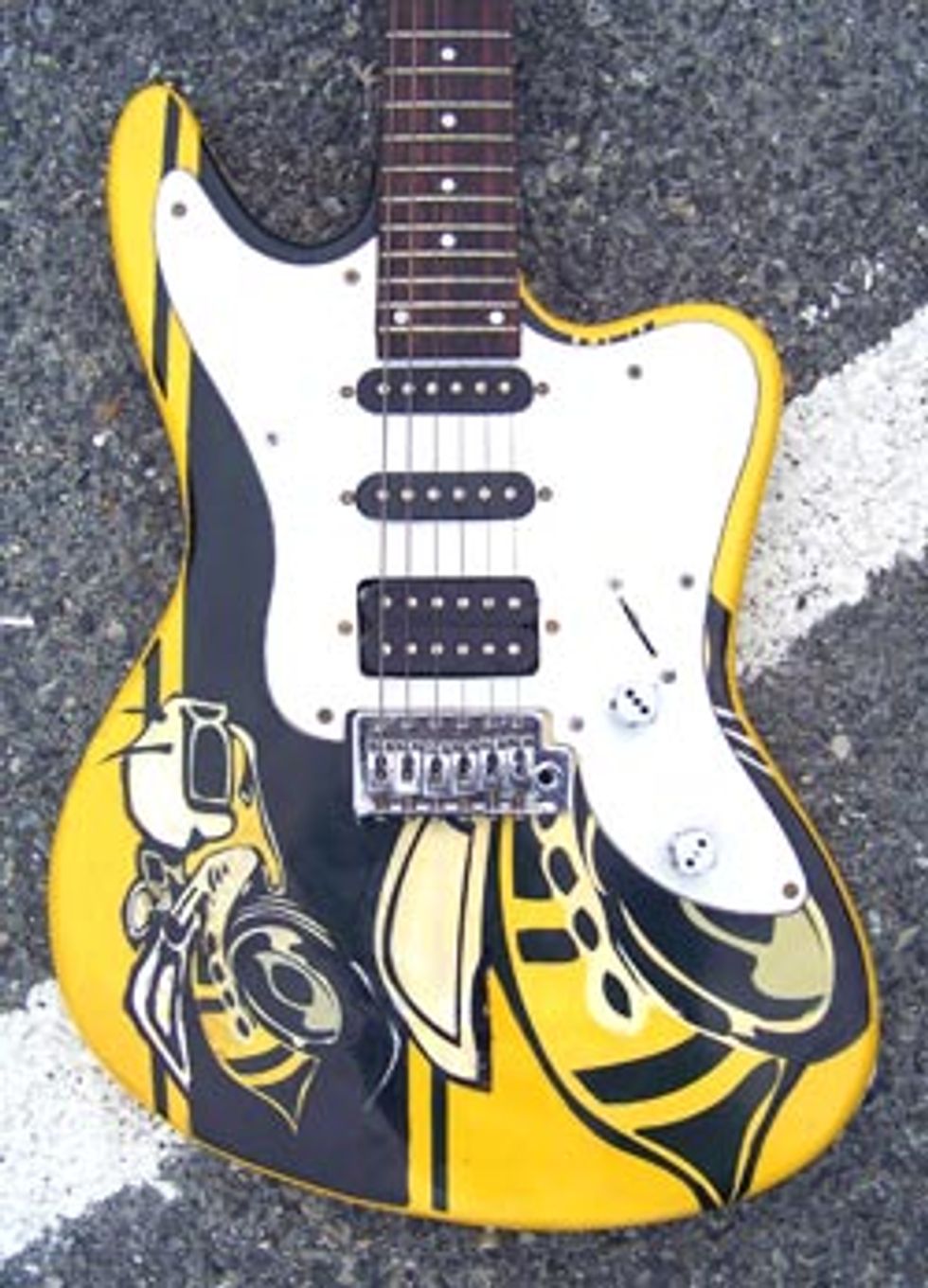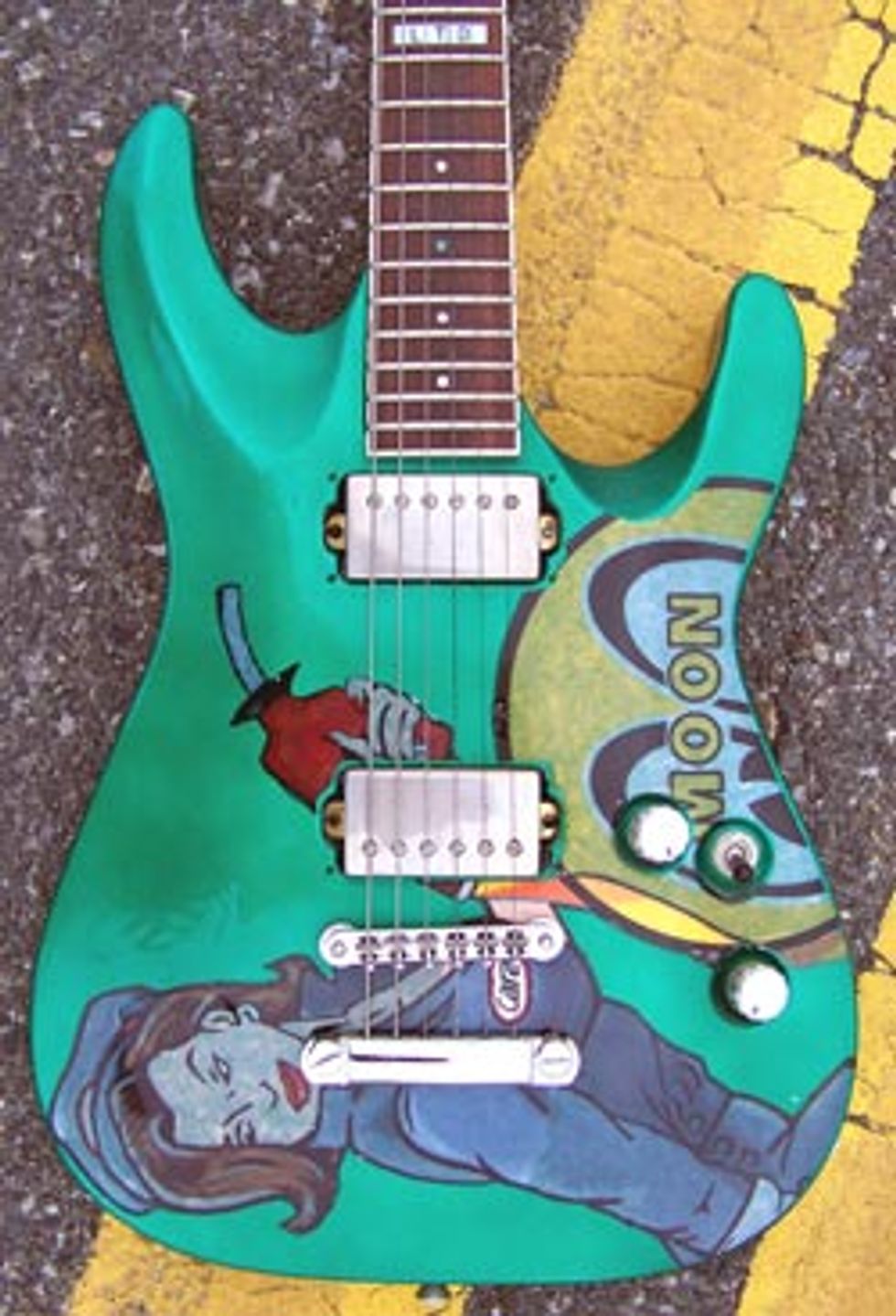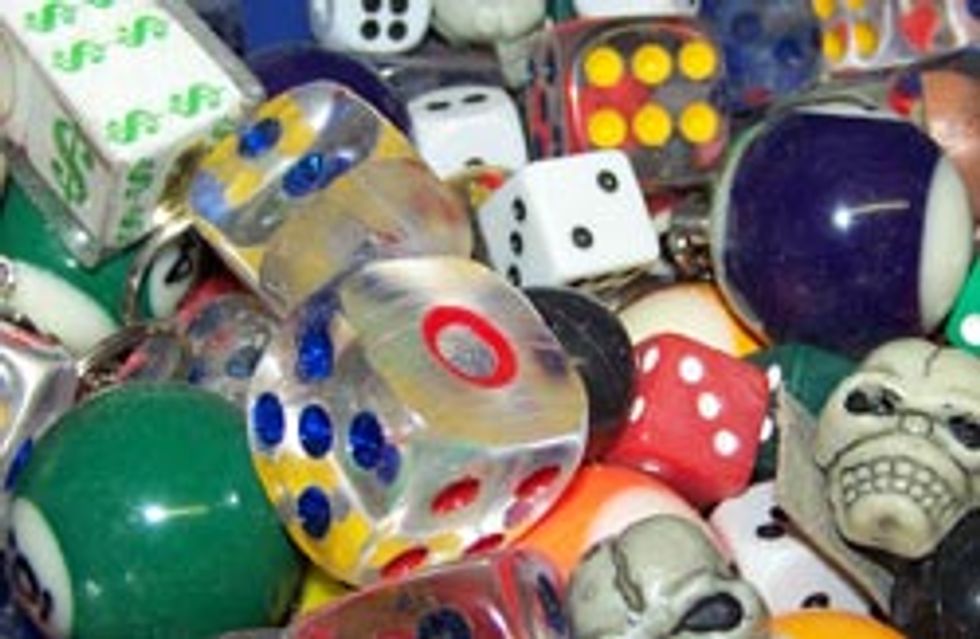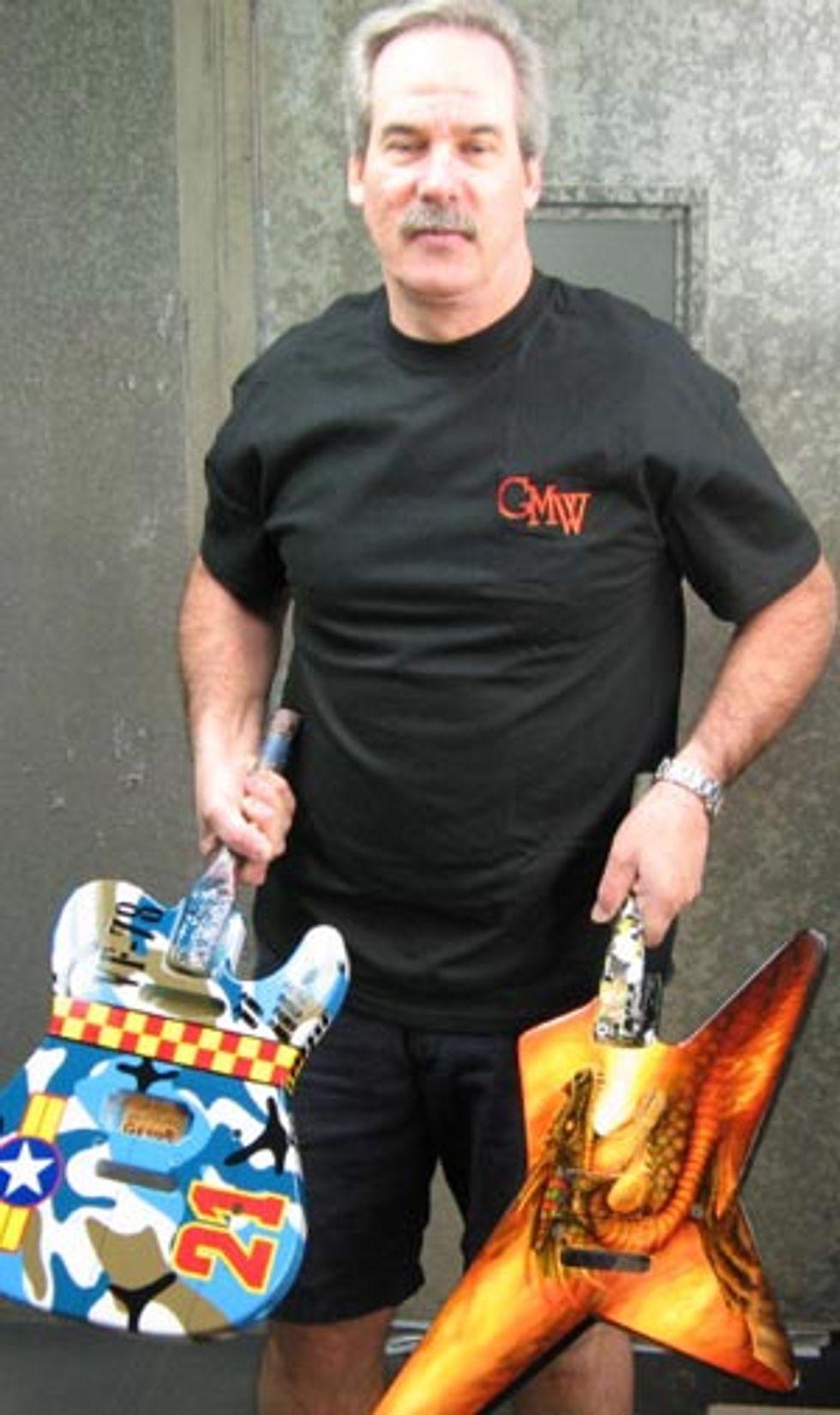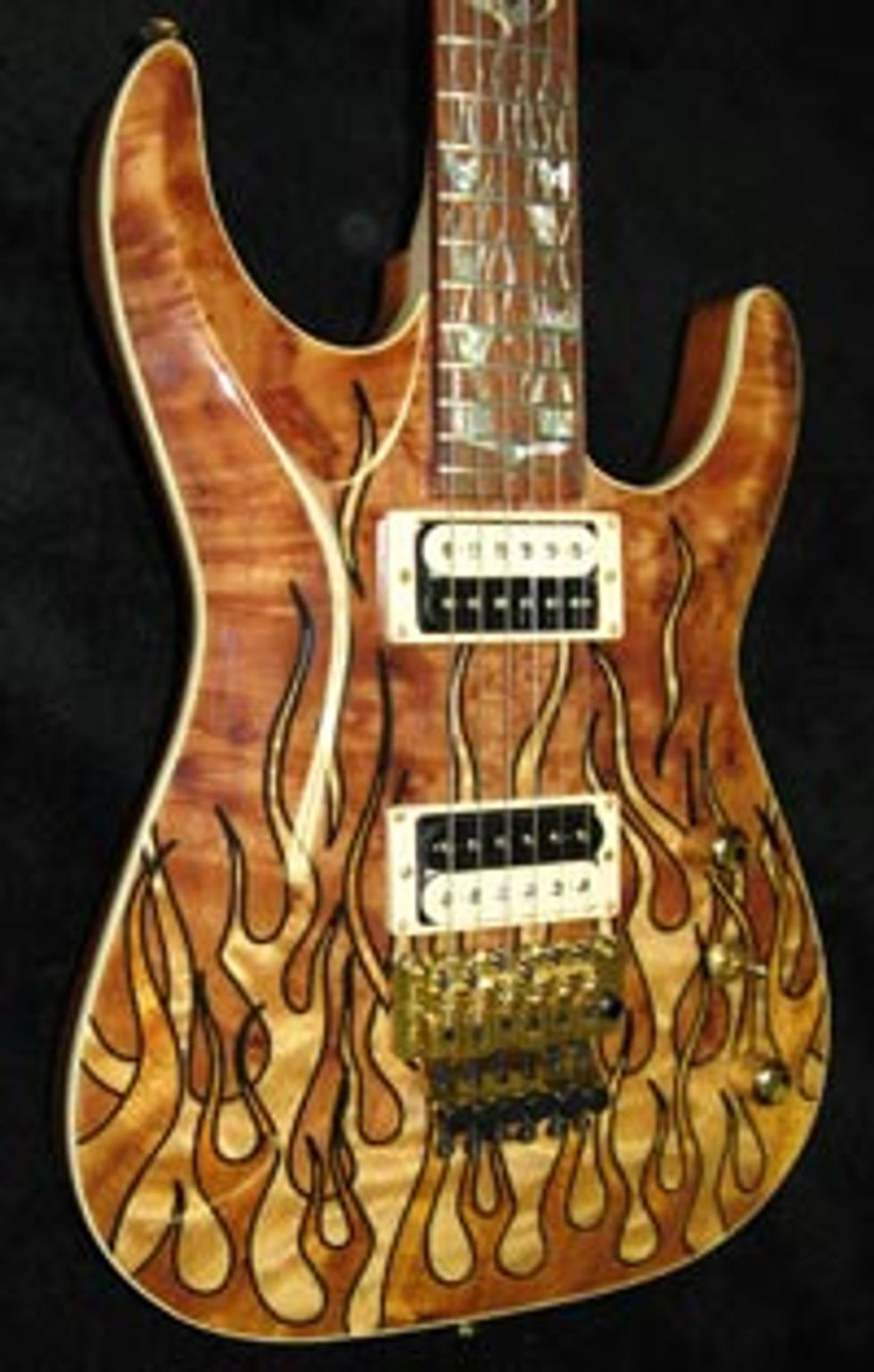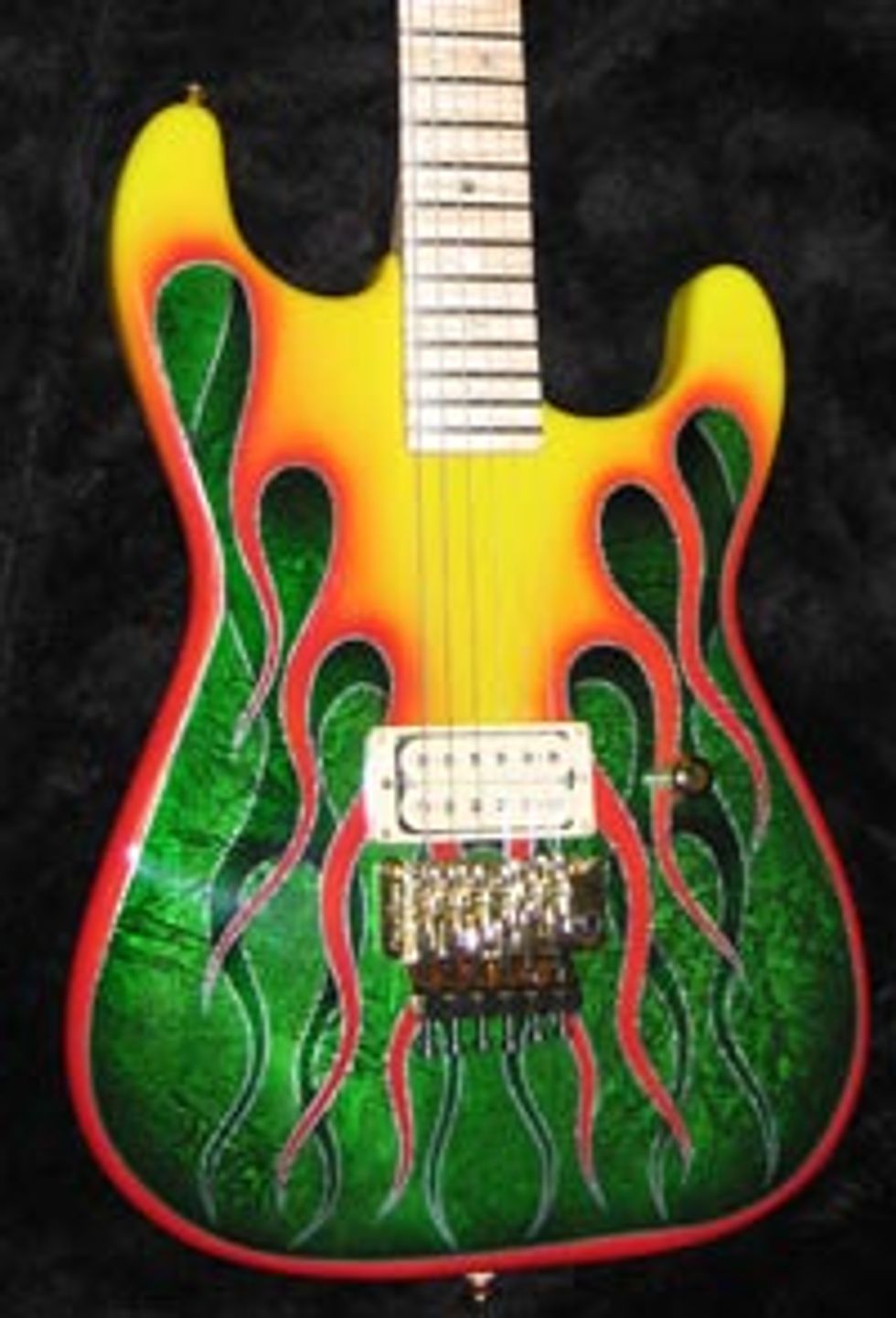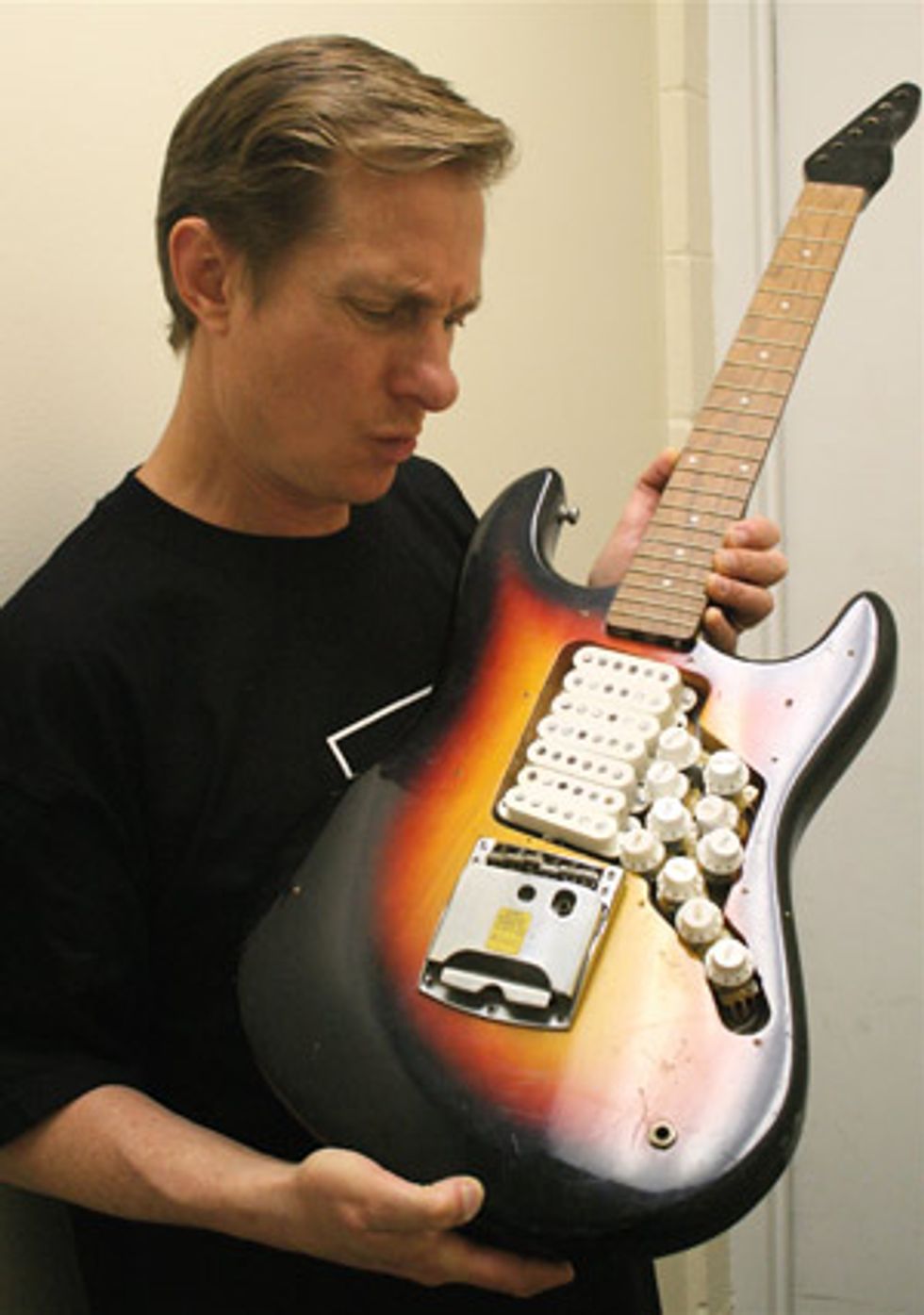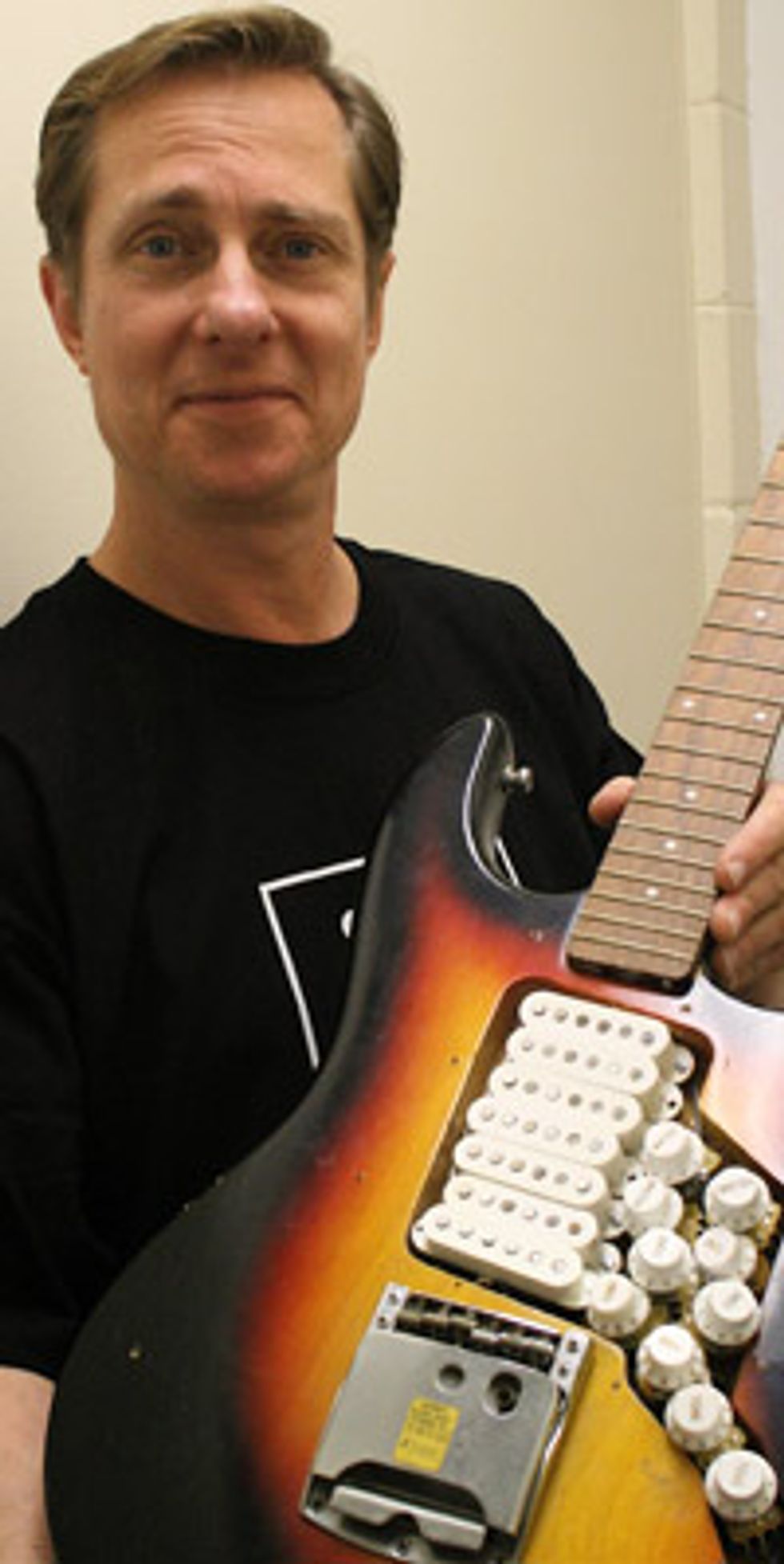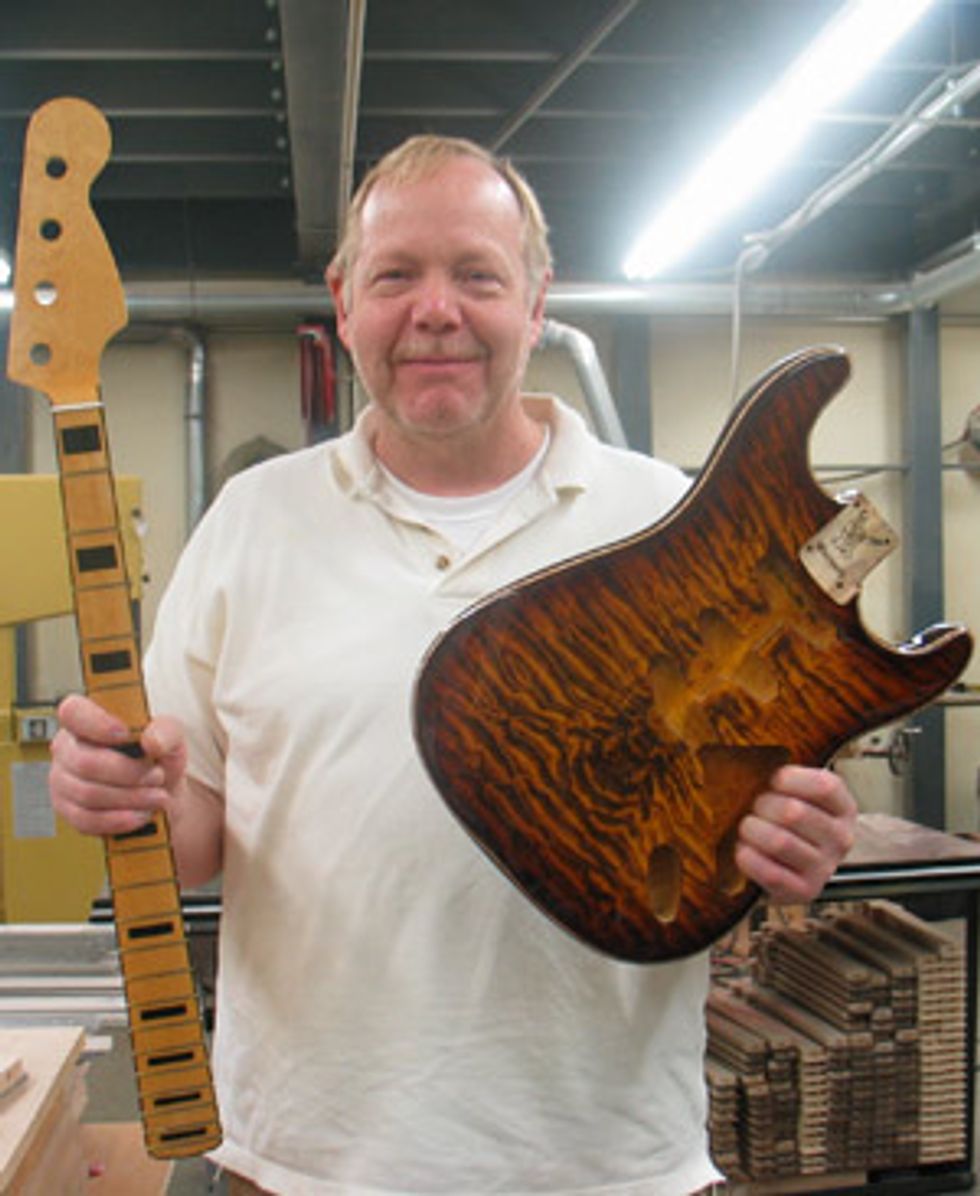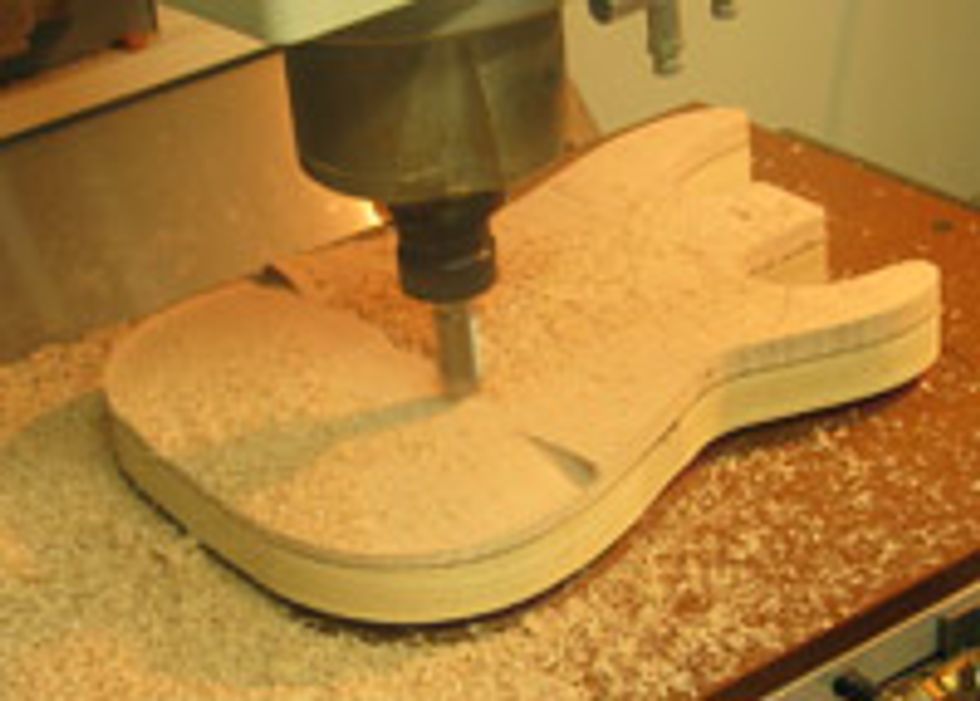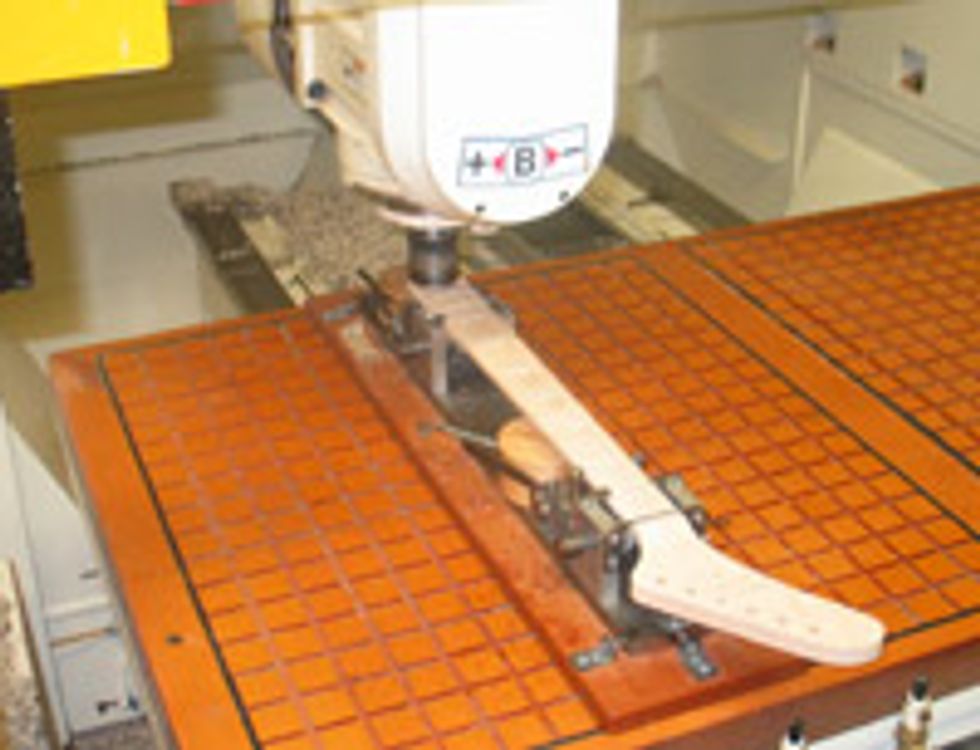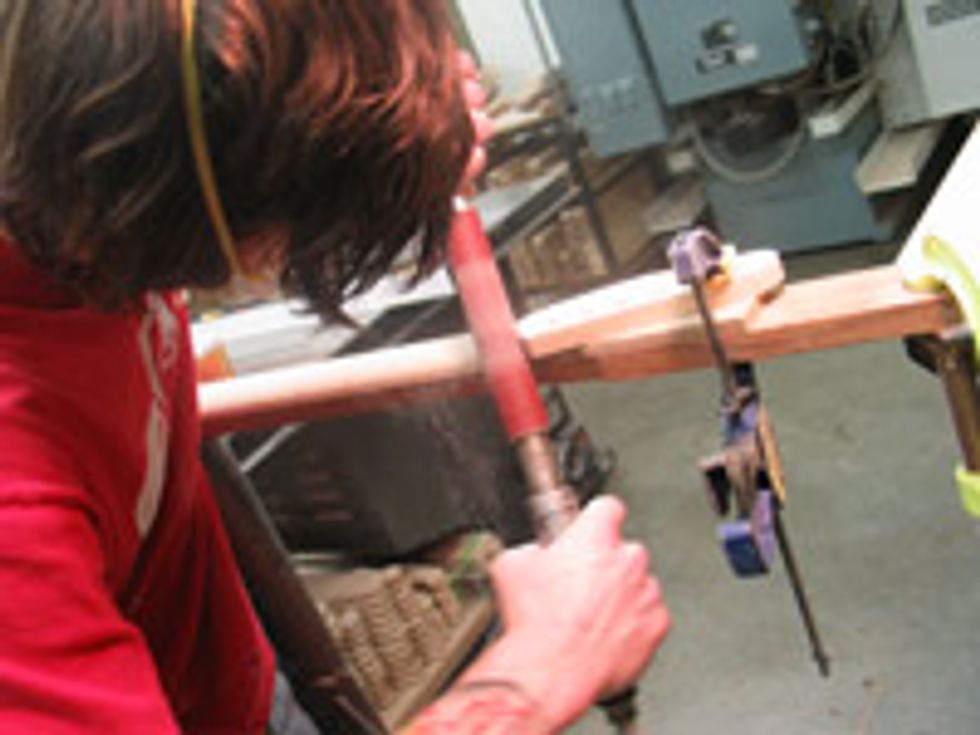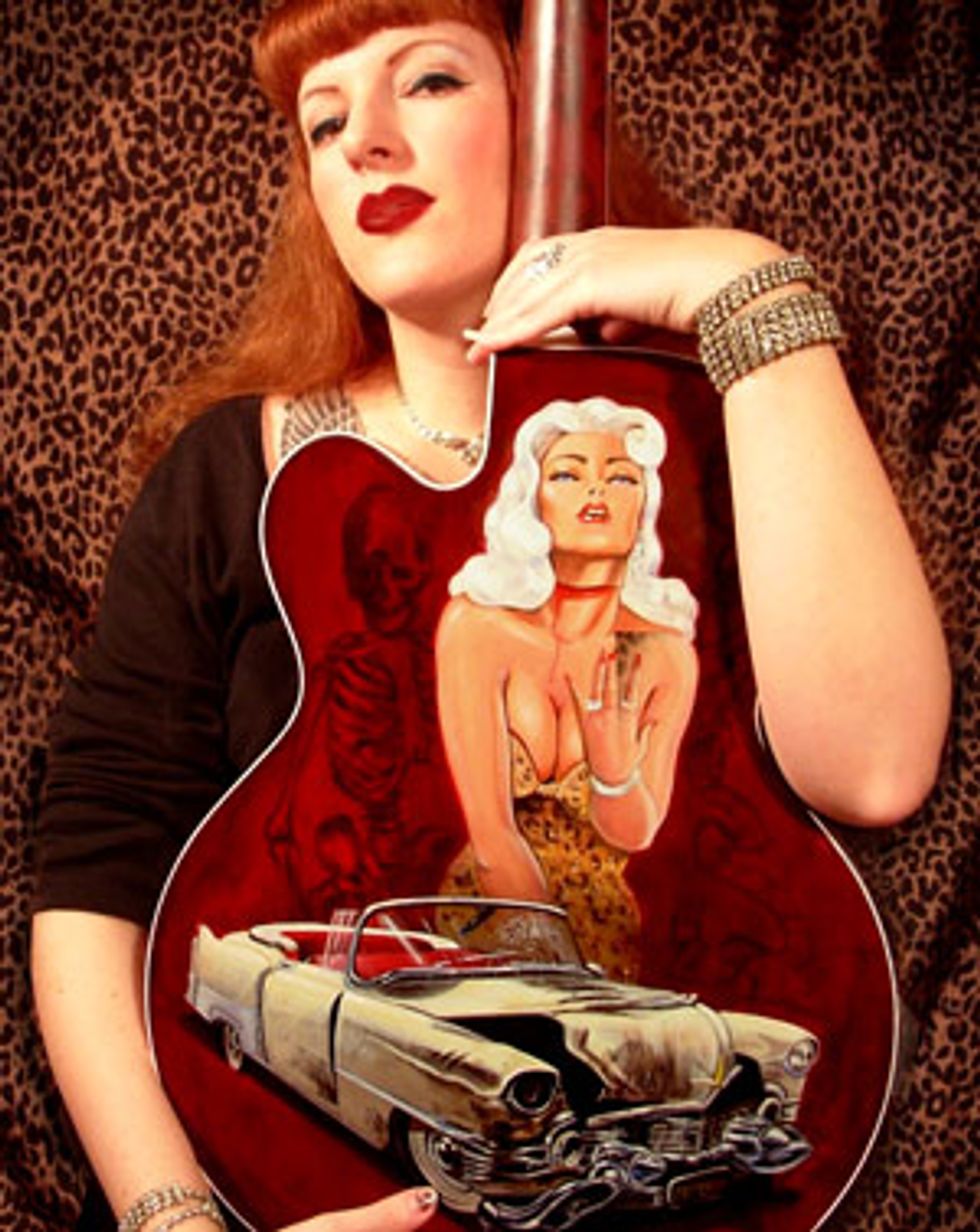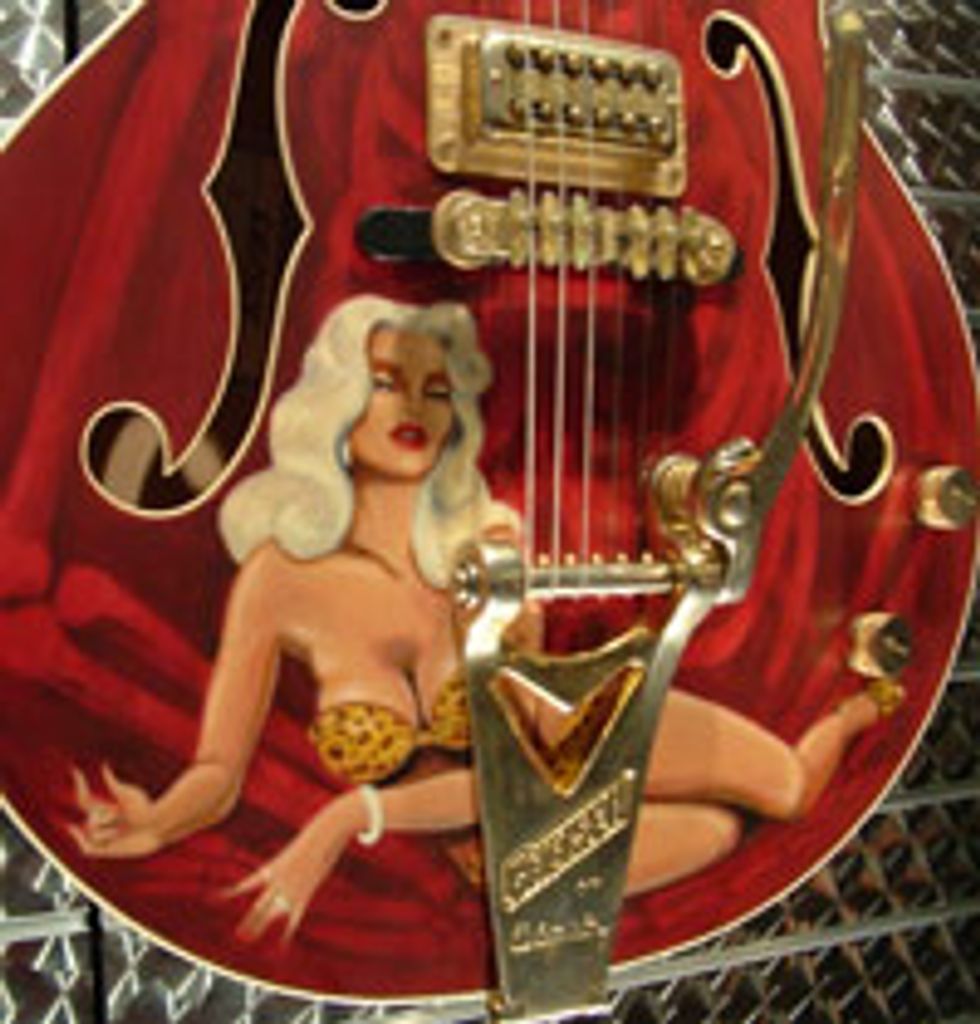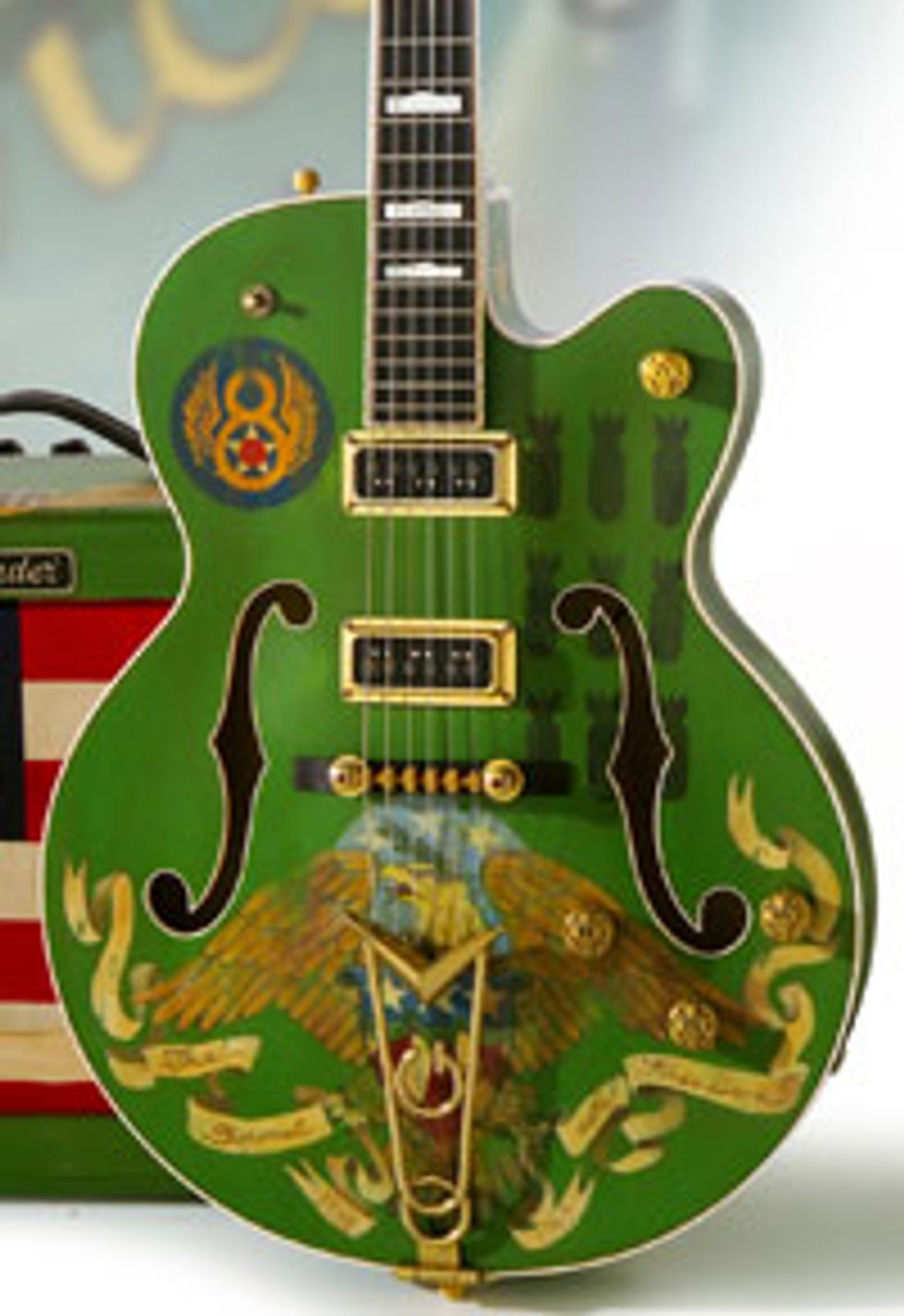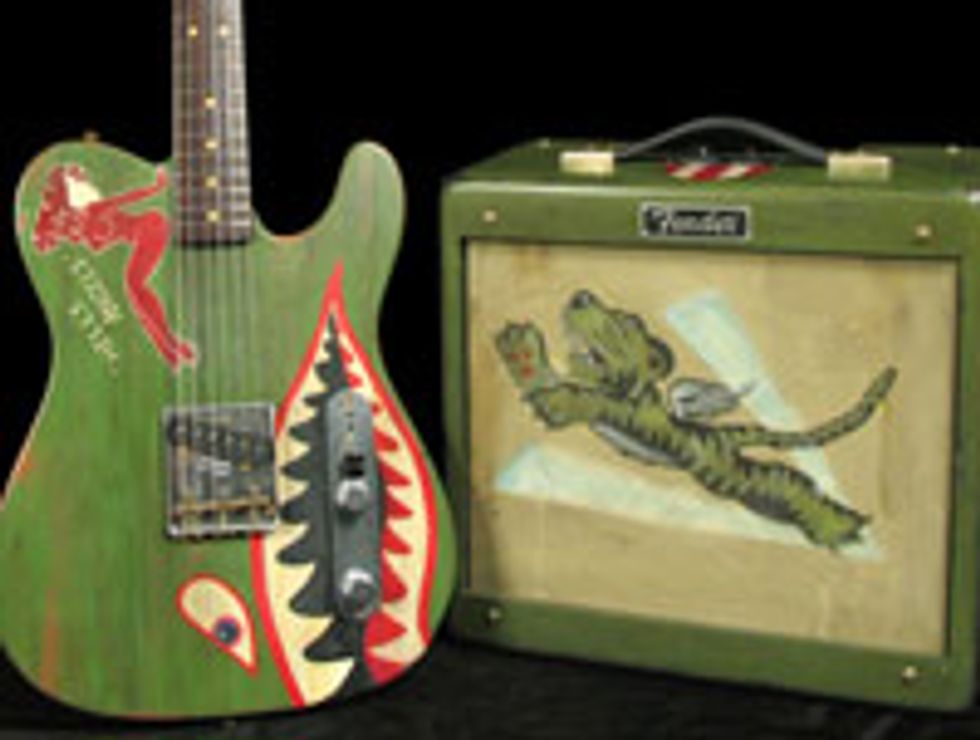We talk to Jim Cara, Lee Garver, Lindy Fralin, Ken Warmoth and Sara Ray about what they do and what the term Hot Rod means to them
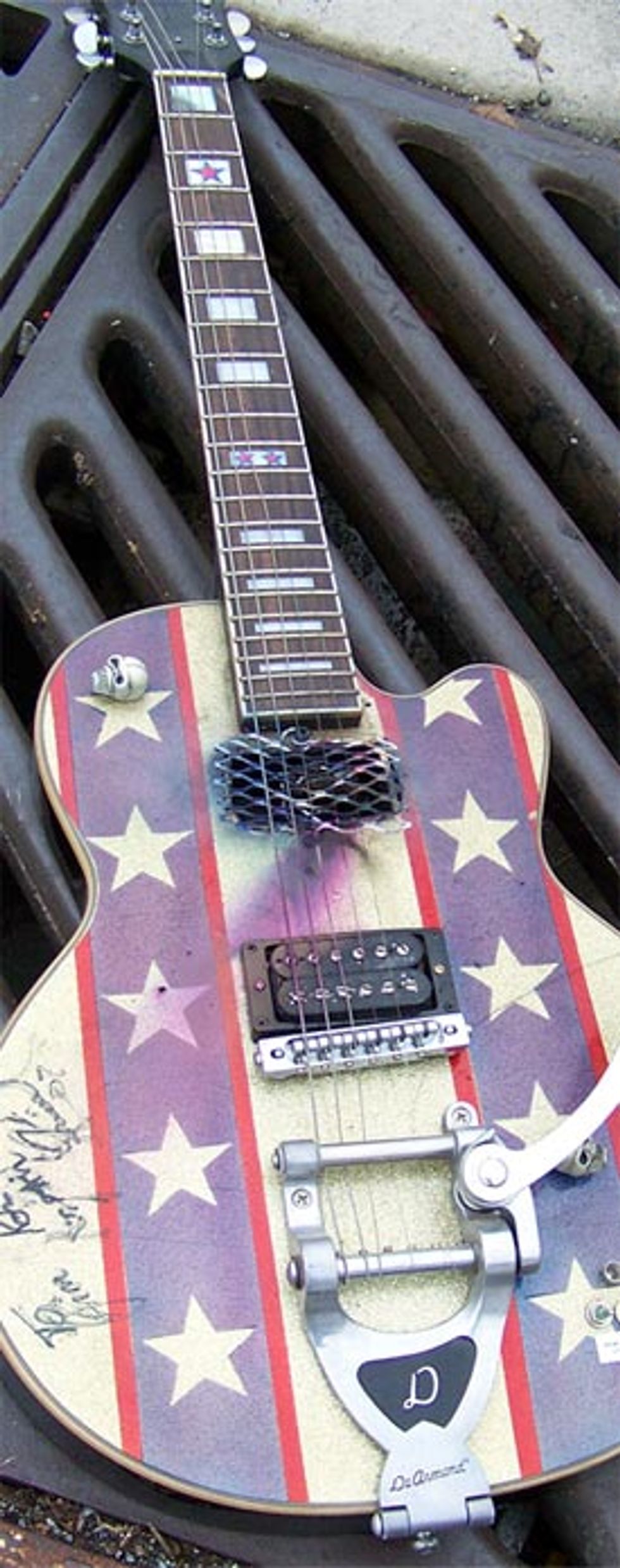 |
|
Check out the builders...
James Cara
Cara Hot Rod Guitar Shop
|
My dad worked in a music store when I was eight years old. I just started hanging out there, and I liked the guitar atmosphere of it, but I was also into Hot Wheels and building model cars. I started working at the store, and after awhile I started putting wheels from model car kits and using them as knobs, decals and flames on the body. Through my whole life, both worlds of guitars and hot rods have always coincided.
With guitars, I never really fell in line with the ordinary stuff. I approached the guitar like the old guys did with their cars. They didn’t go out and look for parts, they went out and made the parts to accomplish the look, feel and drivability they wanted. I always approached it that way with guitars—mostly for a lack of money. I never had a guitar with a tremolo growing up, but I figured out a way to make the bridge wiggle and that was my first modification on the actual guitar setup.
What’s your building philosophy?
First off, you’ve got to figure out what the customer wants out of it and what they want to achieve out of it. They might want EMG pickups, but in your head you’ve got to know why they want these pickups. Is it because they read about them? A friend told them or a famous player uses them? That might not be the right answer. He could be this rockabilly dude who is going with his friends who use EMG pickups, and it’s totally not what he needs to achieve that sound.
Tell me about your pickup selection process and how that works for your Hot Rod shop.
First off, I collect every freakin’ pickup I can get my hands on. I’ve built a device that can test and measure pickups—like a dynamometer for cars. Imagine a guitar sitting on a bench with an arm that hits the strings at a predetermined strength, with a pick on it, and it hits it consistently every time and it has a meter on the output of it, so that you can measure any pickup. I also use a spectrum analyzer to assess what tones and frequencies are coming out of the pickup and how they react to different room settings and setups, which helps decipher what pickups have the clarity, midrange, output, low frequency and breakup point that works best for what a particular customer needs for their tone.
|
Do you construct your own bodies or do you use others as a template for customers?
It’s going back to the hot rod car scene. For instance, you’d walk through an old junkyard with all these mangled cars and you’d say to a buddy, “That’d be awesome if you could fix it up.” So I just apply that same principle to guitars. Any guitar could be a good guitar, if you just put the time and effort into it. We have tons of bodies up on the wall and people can just come in and look around and find a body style to start with, but if they want a custom shape or body, I have a CNC machine I can use through the CAD program and cut it out. While people may want a crazy shape or design, what’s more important to them is the paint, tone and playability.
What’s the process at your shop like?
Since I have years of experience on design and computer graphics, after they decide on a body style and wood choice, I do computer mockups of their guitar with graphics, paint schemes and fully erected on the computer and email them the different designs. It’s totally like Orange County Choppers, where they see everything laid out and completed before it even begins the actual building process. I think that’s the most important thing that we do—they build the guitars with us.
Why should people come to Cara’s Hot Rod Guitars?
Because it’s not one of our guitars, it’s their guitar. They are so involved in building these guitars, and it’s exactly the way they want the tone, look, feel… the whole PT Barnum package. The guitar is all about them. They’re not buying a PRS or Les Paul that’s a different color, they’re buying their own guitar and I’m just making it for them. It’ll be what they wanted or they won’t pay me for it. It’s as simple as that.
Hit page 3 for the second of our 5 Hot Rodders...
Lee Garver
GMW Guitar Works
|
Its funny because my background isn’t in art or paint… I graduated from Stanford with a Ph.D. in Synthetic Organic Chemistry. After doing that in the field for a few years, I realized that I couldn’t do that the rest of my life. I actually got my foot in the door while searching for a keyboard in the eighties. The guy who was selling it to me introduced me to Wayne Charvel. From that point, I had Wayne build me some guitars, and then I met Neal Moser because Wayne was working with BC Rich. Moser got me into the industry by building, and then as we moved into the nineties, it became more autonomous with GMW.
For painting, I set up my own booth in 1990 – 1991, and I had another guy that did all the painting. I just learned by watching over his shoulder, and in 1995 I just took it all over and painted everything myself. I just shut up, watched and took other painters’ advice.
What prompted you to go into the custom, hot-rodded paint world?
I think my influences started from just admiring the Jackson/Charvel and BC Rich companies back in the eighties. I’m a product of the Van Halen, George Lynch and Journey generation. My graphic artist, Dan Lawrence, used to work for Jackson and BC Rich, so I sort of followed into that mold because I loved and identified with those guitars. I wasn’t really a wood-based kind-of-a-guy back then; I was more interested in the graphics and flash on the guitars of those rock bands during that era. We started doing repairs and modifications on Jackson/Charvel and BC Rich guitars, and that’s how I built the GMW name.
As we moved into the nineties and the new millennium, I became disinterested in that kind of work—just this year I stopped doing repairs, modifications and new paint jobs on guitars from other companies, so we could focus solely on GMW and Empire guitars. I just turned fifty-five, so I wanted to take my company in its own direction before the wife puts the hammer down and makes me come home.
What models of guitars are you painting now?
We still have our influences from the eighties and nineties flowing in our shop with the graphics. With the Empire line, we blended it in a manner where we’ll have exotic woods, but the overlays on those will be intense graphics. We’ll cover the traditional guys with straight ahead paint schemes and colors—guys into graphics and eye-catching designs—but also a blend of both those worlds. While they may want different paint jobs and graphics, our client base seems to be rooted in that Jackson/Charvel camp of smokin’ guitars and crazy, colorful designs.
|
Yes, we’re open to custom graphics and paint ideas, but with our extensive online archives, people usually find either a design or paint scheme usually find either a design or paint scheme that works for them. And if nothing else, it provides them a starting point. People just go through our “Generator” on the site and design the guitar how they want, with several options for each area and components of the guitar. When it comes to the paint, they just simply refer to the archived graphic or paint, and we can reapply that design or graphic to their particular body style. Even if the two guitars are different, they can get a basic feeling of what will be the end product.
What seems to be the go-to setup and paint style people go with at GMW?
I’d say most of them are going to be like a Fender Strat or Jackson-esque guitars, which is our SS model. Our graphics and paint schemes seem to just flow and fit better on those styles of guitars. Probably just another nod to our influences… the eighties rock/metal movement, in line with the Jackson Soloist models. But we do stuff on the LP-style, a Star-style and even quite a few Tele-style guitars too.
What are some paint schemes that embodies what GMW is all about?
I’d have to say our hot-rod flame, snakeskin and camouflage models are our most popular, with additional paint schemes on request. Who are some artists you’ve done work for? The most recent were the two polka dot flying Vs for Zakk Wylde, plus we have also built guitars for Pat Smear of the Foo Fighters, Michael Anthony and Dweezil Zappa.
Why should someone buy a GMW guitar?
I think because we give you the most bang for your buck. We simply don’t have the massive overhead that the bigger guitar companies carry, which equates to consistent value. In addition, we listen to what you have to say and what you’re looking for in a guitar, and we make sure the end result is better than what you expected—its all about customer service and satisfaction at GMW. In fact, I answer all the emails personally and within 24 hours.
Hit page 4 for the third of our 5 Hot Rodders...
Lindy Fralin
Lindy Fralin Pickups
|
Well, I do remember when I bought my first hot pickup—it was a Duncan. It had to be around 1981 or so, and it made a huge difference in my Strat. It was a Strat bridge pickup; that was a pickup I thought was too weak. The other two pickups sounded great to me. They sounded like Hendrix, but the bridge was so trebly and thin it hurt my ears, you know?
I remember that all three pickups were about 5.7k. After about a year or two of that pickup being in there—it was a 14k pickup— it became too much. And I started thinking, “There’s gotta be something in between 5.7k and 14k.” Luckily, I met a friend here in Richmond who had been winding his own pickups. He somehow stumbled on a roll of wire, built himself something to spin the pickups and had some success. And after I wound two [pickups] on his, I made myself a similar rig. And I just did that for a while; my band didn’t play a whole lot. [laughs]
Comparing your pickups to the standard fare for Stratocasters, they’re a little more forward voiced, a little more aggressive.
Well, I have always played my amp just on the edge of distortion and rarely use pedals. That way with just how I hit the string, I can go from distorted to clean. A cleaner pickup lets me have really bright rhythms, if that’s what I want to do, or I turn the guitar down or play it softer. Likewise, I can get as nasty as I want by turning the guitar all the way up or changing my attack.
Your website mentions that the Strat is one of your favorite guitars. What’s your idea of a perfect Strat?
The perfect neck, the perfect frets and a really versatile [pickup] set with a hotter bridge. I guess my theory in Fenders is that I want the loudest pickups I can possibly have, but still have brilliant wound strings.
How do you achieve that?
It’s a different pickup for every guitar. And that’s why we make a line with subtle variations between models, because every guitar of mine needs a different amount of power and high end to get what I’m looking for. In a Fender, if you go too far, your wound strings get clogged up. And that’s too much pickup. I would take it back out and go weaker until I got what I wanted. But basically in a Fender I want the loudest pickup I can have that still has brilliant wound strings. I love that sound.
Could you tell us about some of your higher output models?
We use the term “high output” around our shop for pickups wound with 43 gauge wire instead of 42. Because the wire is one gauge smaller, you can fit more turns on a coil. Fender used mostly 42 gauge wire on Strats and Teles; if you want to wind something past a certain output on Strats you have to use a finer gauge wire. So if we use the term high output, we’re using 43 gauge wire. I can still vary the number of turns, but it leaves you room for somewhere between 10 and 15 percent.
Who would you recommend those higher output models for?
Our high outputs are for people who want a thicker midrange and a stronger pickup. It gives you a little longer sustain, a thicker midrange and a little more grind in your chords. The stronger the pickup, the more the tube amp distorts with a chainsaw grind, and that grind gets faster and faster. With a weaker pickup, you can get it up loud enough to distort the amp,
|
I know you handwind each pickup, but do you do custom builds? Or are customers limited to your established models?
We will build anything a customer can think of, with the parts available to us. An incredibly high percentage of our stuff is custom wound for somebody. They look at all of our models and still say they want something in between two specific models.
What is hot-rodding a guitar to you?
It’s making a guitar better in any way. To one guy, it might be bigger frets. The first time I put big frets on one of my Fenders, I was the happiest guy in the world. When you narrow it down to pickups, it’s just getting them to do what you’re hearing in your head. There isn’t a perfect pickup for everybody; with us, it involves having a lot of options, listening to people and finding what they’re looking for.
Hit page 5 for the fourth of our 5 Hot Rodders...
Ken Warmoth
Warmoth Guitar Products
|
What did you want to provide to people? I began working with my dad at Boogie Bodies way back in 1978, and ended up running this enterprise up until early in 1980, when we dissolved that partnership and started up Warmoth. Dad was the machinery guy, he built the cool tools used to make necks; his partner was the guitar junkie/salesman. We supplied many parts to Charvel in their early years, but for the most part, we simply sold wholesale to guitar techs around the country. Warmoth supplied many of the early boutique builders, the biggest of which was probably Valley Arts, while they were still a California company.
We began making necks because nobody else was doing it, and there were a lot of Fender guitars with trashed necks. This was in the years prior to the “vintage” market and, hence, putting a new neck on your ‘66 Strat was no big deal—it was even less of a deal on your CBS-era guitar that could well have come from the factory with a crappy neck. Most Fenders of the era had 1-5/8” wide necks with 7.25” radius fingerboards, and there was a buzz for wider necks and flatter fingerboards with Gibson frets; this is the bandwagon we jumped on.
The old Charvel guitars used by Van Halen had necks that we built on them—I know there has been a lot of fame-claiming on this one, but the fact remains that Warmoth built all the necks at Boogie Bodies with 1-3/4” wide nuts and a 10” fingerboard radius!
What should guitar players ask themselves before purchasing a replacement neck?
Guitar players don’t really analyze what it is about the mechanics of a neck that they like or hate. They do with pickups and bridges, but not so much with necks. If they’d simply get out of the idea that one size fits all, they could look at the size of their hand, the diameter of their fingers and ask themselves if a wider or narrower neck might be more accommodating, or if a different neck profile might make their fretting hand more comfortable. There has been more recognition of this in the past decade, however it still gets little coverage in the magazines. I would pose a few questions that might have great interest to your readership:
How does fingerboard radius effect neck playability?The list could go on and on in the parts/ custom guitar arena.
What is the compound radius?
How does neck thickness affect tone and or sustain?
How does nut width effect neck playability?
What are the advantages and disadvantages to the new stainless steel frets? Do they affect tone?
What are the advantages and disadvantages to the different nut materials available?
Locking tuners versus non-locking tuners: how do Sperzels compare to Gotohs or Schallers or Planet Waves?
What can you provide players that other people or companies can’t?
To the best of my knowledge, nobody else offers a scalloped replacement neck—either a half or full scallop. No other outfit offers as many radius options, fret options, preps for locking nuts, LSRs or compensated nuts. Heck, nobody else offers precut nuts fitted to the individual neck, regardless of fret size or fingerboard radius (and no, there is no generic precut nut, off the shelf, that is going to fit well in any neck). Nobody else offers peghead veneers or custom inlay like we do. If you want much, say, in the way your neck is going to be made, and you want it at a reasonable price, there really aren’t a whole lot of choices out there.
|
Usually not, although we have done such necks in the past. Unfortunately, the cost for a craftsman to hand-fabricate a neck to very specific requirements takes a lot longer than pre-canned CNC operations with preprogrammed options. Ninety-nine percent of the guys wanting a completely custom neck for some esoteric guitar don’t have a budget to compliment it.
The phrase “parts guitar” is often used by guitarists in a less-than-positive sense. How would you respond to that?
A DIY guy can come up with a “parts guitar” that is like no other. He can appease his own heart’s desire with no regard to whether anyone else in the whole world likes his ideas or not. As long as he’s happy, who cares about the critics? Tons of players have been totally frustrated because they were unable to find a factory guitar that suited them, and they can’t afford to have a boutique guy do the job for them. Where else can they turn but the DIY parts guitar realm? I really feel like we’ve pioneered the DIY guitar parts market, leading the way for others and offering opportunities that otherwise wouldn’t exist. In the years to come, I only see this market growing as more and more players discover what it has to offer them.
Hit page 6 for the last of our 5 Hot Rodders...
Sara Ray
Sara Ray Studios
|
A lot of the guitar heroes have hot rods and whatnot; I think it’s all part of the customized lifestyle. That’s where you want more out of everything. You can start out with what everybody’s got, and that’s fine, but some people want to add their personal touch to it. It’s all very personal—some guys will paint a ridiculously out-of-control, chopped and dropped hot rod bright pink— it’s just what they want. There’s no way to rationalize it, because it’s all personal taste. You grew up around hot rods, right? Yeah, living in California and having a family that was involved heavily in that, there were always custom cars around. I literally grew up on the beach, and that’s where you’d take your car: down to the beach. There’s a big culture of it that really began out here.
You’ve done some cool work with fellow SoCalites at Fender’s Custom Shop. How did that come about?
Someone at Fender/Gretsch came to me… I think they actually found me at one of the big car shows, because a lot of the builders love cars and motorcycles, and they’re usually there. And they asked me if I’d paint a guitar but they didn’t give me a theme. That turned into the Victory Guitar, which was a Gretsch 6120 that was going to be for the NAMM show in Tennessee. I did a WWII [theme], not really sure what they wanted from me, and it’s now on display at the 8th Air Force museum.
Did the company just send you a 6120?
When I get the guitars, it’s just the bodies usually, but sometimes I get the neck too. It all varies; every single one has been different and there’s really no standard. But I live fairly close to the custom shop, and the builders all live around me, so it’s pretty convenient. I can call them or they just come by the house—they like coming by the house anyway, because they get to see all my stuff.
I understand you do an impressive amount of research on your projects.
Some people have a limited knowledge of what they’re looking for, especially with history and artifacts, like airplanes. I make it a point to spend a lot of time around the actual things I admire like that. I’ve been on most of the airfields on the West Coast and to military museums all throughout Europe. I meet a lot of people that are involved with it, and so I have a big network of people that I can go to for information.
It’s really important for me that it’s as historically accurate as it can be for a paint job. I’m not sure what it is, but ever since I can remember, I’ve always been completely enthralled by history and wars and whatnot. I think it’s a past life kind of thing. [laughs]
|
They’re all antiqued generally. I don’t think there are a lot that haven’t been aged that much. But being surrounded by antiques, I like them better. Everything I have is older and some of the stuff I have is almost ruined, old and just falling apart, but it gives it such personality. I try to take that and reproduce it on something to give it a little bit of history, to give it a little bit more story. I don’t really buy anything new that I don’t have to; everything is old and beat up, and when you have a house filled with that, it really is a whole different kind of world.
You’re also using a matte finish on a lot of these guitars.
Yeah, pretty much. I don’t think I’ve ever been asked for a gloss finish. If it’s a Masterbuilt guitar, we talk about what it should look like when it’s done, and they’ve all agreed with me on the finishes I pick. It’s all been matte or satin; there have been a couple of flats, but I don’t think I’ve done a glossy one yet.
And if I customer is interested, they should just get in touch with you?
Definitely. I tell people, “The quickest way to get something done by me is to get it started.” If you wait and you want deadlines, there’s no way to know because each project is so different and there’s really no set standard of how long it’s going to take or what I’m going to do with it. The Red Baron guitar took three whole months, and it was just an adventure in guitars. I lived and slept it for three months; it was constant reference work. I flew to London and went to the Imperial War Museum. And then some only take me like two weeks. I like to do pinups that are a little different, and I can do those fairly quickly, but it still requires two solid weeks of work. I wake up, I have my coffee and start and don’t stop until the sun comes up.
